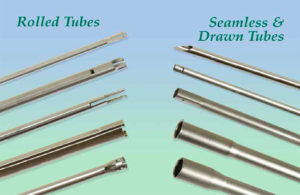Most small hand-held devices used for surgery include some type of tubing technology. The design engineer ultimately must decide whether drawn tubing or a rolled tube technology will best suit a particular device.
Jim Jock, Micro

The following factors need to be considered when deciding which metal tube approach to use – a drawn tubing or a rolled tube method. These factors include the size of the component being manufactured, tolerance and thickness of tubes, movement versus rigidity of the instrument, and the features required on the tube itself.
Drawn tubing allows for greater control of tubing dimensions such as straightness or diameter consistency, particularly when tightly controlled dimensions are required throughout the whole length of the metal tube shaft. Drawn tubing is also more conducive to creating certain end features, such as flaring and flanging, expansions or reductions, and end sharpening.
Not all drawn tubes have to be round. They can also have an octagon cross section, oval or D-shape, just to name a few.
In manufacturing metal tubes, the rolled tube technology method is better suited for high-quantity orders such as those greater than 300,000 pieces. This method requires the use of a progressive stamping die and raw stock in coil form, usually stainless steel for surgical instruments. Features – such as holes, slots or windows – can be punched into the coil stock in the early flat blank stages of the stamping procedure.
After these stamped features are completed in the stamping tool, a rolling process begins, in which the flat stock material is finished into a tube shape. It is actually possible to stamp and roll a finished tube off a stamping power press in a few seconds, versus cutting drawn tubing stock to the correct length, cleaning it and putting secondary features in afterward.
Using this rolled tube technology for metal tubes can significantly reduce component and subassembly costs when it is used to manufacture endoscopic subassemblies. Products that tend to fit into this category include scissors, graspers, dissectors and tissue-holding forceps that support endoscopic procedures.
Most small hand-held devices used for surgery include some type of tubing technology. In the design phase, the design engineer ultimately must make the choice between using drawn tubing or a rolled tube technology. Decisions are based on quantities, cost and the features necessary for the end-product, all an integral part in bringing a new medical instrument to market.
Jim Jock joined Micro in 2001 to manage all corporate marketing activities. He has been involved with the metal stamping and manufacturing industry for more than 40 years.
The opinions expressed in this blog post are the author’s only and do not necessarily reflect those of Medical Design and Outsourcing or its employees.

